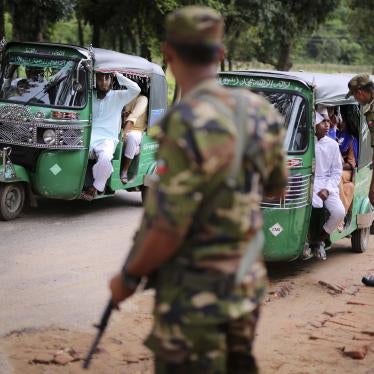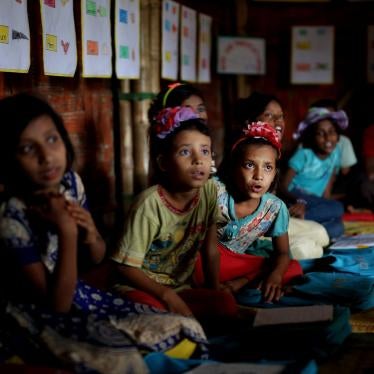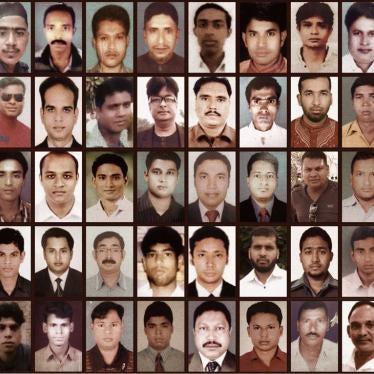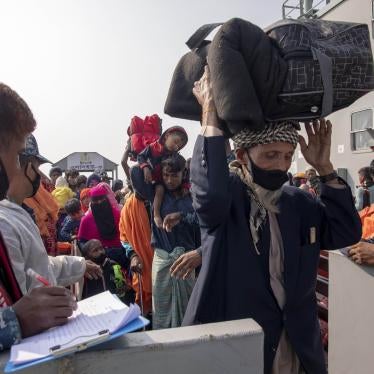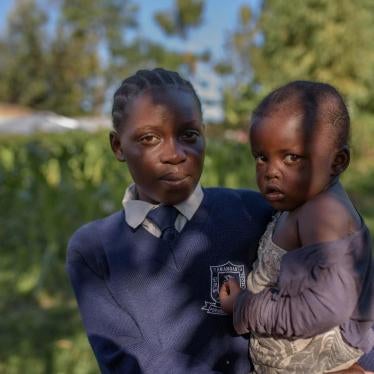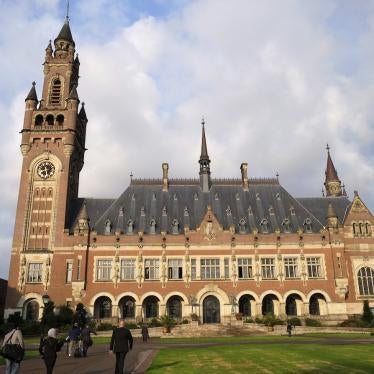July 2022
Human Rights Watch is an independent, international human rights organization that monitors, reports, and conducts advocacy on human rights in more than 90 countries globally.
Human Rights Watch welcomes the opportunity to provide input to the Committee on the Rights of Persons with Disabilities (the Committee) ahead of its upcoming review of Bangladesh. This submission highlights areas of concern that Human Rights Watch hopes will inform the Committee’s consideration of the Bangladesh government’s compliance with its obligations under the Convention on the Rights of Persons with Disabilities (CRPD).
This submission relates to articles 6, 7, 9, 10, 11, 13, 19, 20,24, and 25 of the CRPD. It draws upon Human Rights Watch’s research published in 2018, 2019, and 2021 documenting the failure of the Bangladesh government to protect the safety of persons with disabilities in the context of the Rohingya refugee crisis and to ensure access to education for refugees with disabilities.[1] The submission also includes research documented in a 2020 report on barriers to legal recourse and support for survivors of gender-based violence. Finally, it includes commentary on accessibility of public services, including healthcare and courts, based on existing research by disability rights experts and communication with disability rights activists. It proposes issues and questions that Committee members may wish to raise with the Bangladesh government.
Background
Bangladesh passed the Persons with Disabilities’ Rights and Protection Act (the Disability Act) in 2013 to incorporate into domestic law Bangladesh’s obligations under the CRPD. While the Disability Act was a positive step towards protecting the rights of people with disabilities in Bangladesh, nearly a decade later significant gaps in implementation remain, some of which are discussed in the sections below.
Accessibility (art. 9) and Other Impediments to the Right to Health (art. 25)
The Disability Act requires that all public places, transportation, and services be physically accessible and include accessible information and communication for people with sensory (visual, hearing, or speech) disabilities. Bangladesh’s 2008 National Building Code additionally requires minimum standards of building accessibility.
In practice, Human Rights Watch and organizations in Bangladesh have found that these requirements generally have not been implemented and that this creates a significant barrier to the enjoyment of other rights, including access to health care services.[2] Public transportation rarely includes wheelchair access, making it difficult to travel to essential services or to live independently.
A 2020 study by the James P Grant School of Public Health at BRAC University surveying 5,000 people with disabilities and visiting 18 health facilities in Bangladesh found that many health centers lacked adequate ramps, doorways, and corridors to allow for wheelchair access and many lacked accommodations for people with sensory disabilities.[3]
The BRAC University study also found major gaps in the provision of sexual and reproductive healthcare (SRH) for people with disabilities, in part stemming from a harmful perception in Bangladesh “that persons with disabilities are asexual, or less sexually active, therefore less likely to have SRH needs or to be exposed to sexually transmitted diseases and/or different types of violence.”[4] This stigma alongside limited training on inclusive care for healthcare workers means people with disabilities in Bangladesh often face additional barriers to seeking sexual and reproductive healthcare beyond physical accessibility.
According to BRAC University’s 2020 study, sexual and reproductive health “services of person[s] with disabilities in Bangladesh are limited if not restricted to pregnancy related services, family planning and a handful of screening and treatment of sexually transmitted diseases.”[5] The lack of available interpreters at healthcare facilities also means that people who require these services are often forced to rely on a family member to provide interpretation which can violate the principles of privacy and confidentiality in accessing health care services.[6]
Human Rights Watch encourages the Committee to ask the Bangladesh government to:
- Ensure healthcare buildings are accessible in accordance with the CRPD, the Disability Act, and the 2008 National Building Code, including by making adequate safe wheelchair ramps, wide corridors and entryways, and accessible bathrooms.
- Train healthcare workers in providing inclusive care to people with disabilities, including related to sexual and reproductive health.
- Ensure all healthcare facilities make interpreters (of the same gender when requested) available for people with sensory disabilities.
Women with Disabilities (art. 6), Accessibility (art. 9) and Access to Justice (art. 13)
Women and girls in Bangladesh in general face widespread gender-based violence and barriers to accessing justice.[7] Women and girls with disabilities are both at increased risk of violence and face additional barriers to seeking safety and services.
Bangladesh’s 2013 Disability Act includes measures intended to ensure that all people with disabilities have equal access to legal recourse and protection under the law. The law includes prohibitions on discrimination by government authorities against someone with a disability and criminalizes preventing a person with a disability from accessing justice. Police, prison, and court officials are required to undergo training on disability rights and the government is required to ensure that courts are accessible for those with disabilities, including by making an interpreter available.[8] Bangladesh’s Evidence Act, 1872 requires that any witness with a speech or hearing disability be able to give evidence through any other means, including in writing or by sign language.[9]
Human Rights Watch’s research published in 2020 found that police, prison, and court officials often are not sufficiently trained in disability rights and necessary accommodations.[10] Some courts and police station Victim Support Centers have Bangla sign language interpreters, but these interpreters are not always available, the study found.
Bangladesh courts are rarely accessible for people with physical disabilities—the lack of wheelchair accessibility, ramps, elevators, or adapted seating in courts act as barriers for many in seeking justice. Those with sensory disabilities are often left without any way to communicate with police officers when reporting violence or when giving evidence in court because the government has failed to provide promised support for communication and other forms of reasonable accommodations.
Human Rights Watch encourages the Committee to ask the Bangladesh government to:
- Ensure that courts, public hospitals, police stations, prisons, Victim Support Centers, and One-Stop Crisis Centers are accessible according to stipulations under the 2013 Disability Act, including both physical accessibility and access to an interpreter or support person (of the same gender when requested). Ensure that witnesses with hearing or speech disabilities are able to provide evidence through an alternative means as provided by the Evidence Act, 1872.
- Ensure that all police, prosecutors, and court officials undergo training on disability rights and disability-related accommodation according to the stipulations under the 2013 Disability Act.
- Implement the Legal Aid Services Act, 2000 which requires that all women and girls with disabilities have access to free legal services.
Rights of People with Disabilities in Rohingya Refugee Camps (arts. 9, 10, 11, and 20)
For people with disabilities in the Rohingya refugee camps—some of whom have disabilities as a result of the violence that forced them to flee—daily life in the camps carries the risk of injury as accessibility necessary to meet basic needs is badly compromised.[11] Despite efforts by the United Nations, humanitarian organizations, and the refugees themselves to build handrails and make pathways throughout the camps more accessible, many walkways in the Rohingya refugee camps are impassable for people who have difficulty walking. Hussein Ahmad, whose 17-year-old son was shot in the neck during their escape from Myanmar and is now paralyzed from the waist down, said: “I thank the doctor who gave my son a wheelchair, but I can’t use it because the roads are very dangerous and keep getting worse. It is time for my son to study, but he can’t walk, and his life is being destroyed in front of me.”[12]
Work to shore up the hastily and haphazardly built huts and other camp structures has been hindered by the Bangladesh government’s insistence that the refugees are only staying temporarily and will soon return to Myanmar. The authorities have resisted developing or allowing humanitarian or refugee actors to build camp infrastructure that would suggest a longer-term stay. As a result, nearly 5 years after the camps were established, there is still insufficient lighting, accessible toilets, and proper walkways with handrails that are critically important for people with disabilities and the rights that depend on accessibility.
Yasmin, orphaned at 16, told Human Rights Watch that she was shot fleeing her village, and her sisters carried her to Bangladesh where she was treated for her wounds. At the time Human Rights Watch interviewed her, Yasmin said she had ongoing problems but could not afford medicines and had been given no assistance to support her mobility and had to rely only on her sisters to assist her to move. Although she qualified because of her disability on several grounds for the UN’ refugee registration category of “extremely vulnerable individual,” and should therefore have been eligible to receive specific services and assistance, Yasmin said she had not received any such support:
It is very difficult to walk in the camp. I can’t move around by myself. I don’t have a cane. I need to lean on my sisters to walk. My hut is very small and has no bathroom, so I need my sister to take me to the bathroom at night. The drinking water supply is very distant from my hut. I have a registration card, but I don’t know anything about “vulnerability.” I don’t get any different food or assistance than anyone else. I need medicine, but I have no money, so I don’t get any. […] I don’t go to school. I don’t have an education. I am unable to go to school because of my injury.[13]
Kahimullah, age 70 and partially blind with respiratory problems and difficulty walking, was not receiving any specialized services or assistance at the time Human Rights Watch interviewed him. He and his wife were living on a steep incline in a tiny hut next to a fecal sludge pond. Kahimullah said:
I feel danger where I live, but I have no other options. If strong winds and rain come, maybe someone will come to help us. There is a bad smell here and we have lots of mosquitoes. I have a donated mosquito net, but it is not sufficient. The toilets are not clean. Because I am blind, I can’t go outside. I can’t get food rations, I have no money for fish or meat. I am dependent on humanitarian relief.[14]
Distant and inaccessible latrines and toilets were the most common complaint from people with disabilities. Arefa, a 60-year-old woman with hypertension who Human Rights Watch visited as she was lying on the floor of her hut with an IV bottle dripping into her arm, said, “I need help to move. There is no latrine or toilet nearby. I am not able to walk by myself. I need someone to help me to walk.”[15]
The failure of the Bangladesh government to fulfill its obligation under article 11 of the CRPD to ensure the protection and safety of persons with disabilities in situations of risk, including armed conflict, humanitarian emergencies, and natural disasters has been evident as large, deadly fires have repeatedly swept throughout the Rohingya refugee camps in recent years.[16] Not only have people with disabilities been overlooked in emergency evacuation planning, but the government has trapped people inside the camps by erecting barbed wire around the camps, as well as between different areas inside the camps. Human Rights Watch found that the fencing has limited the ability of people with disabilities to flee.[17]
Human Rights Watch encourages the Committee to ask the Bangladesh government to:
- Lift restrictions on construction in the refugee camps that prevent the necessary infrastructure for mobility for persons with disabilities.
- Ensure persons with disabilities, including those with newly acquired disabilities due to the attacks in their home country or injuries sustained in the refugee camps, are explicitly identified as a high-risk population.
- Ensure toilet and bathing facilities in camps are accessible for people with disabilities and adapted so they can use them while ensuring privacy and dignity.
- Ensure alternative means of distribution and delivery of food and medicine for people with disabilities and other groups such as older people.
- Stop all fencing of Rohingya refugee camps and ensure that people with disabilities can safely evacuate in case of fire, flood, monsoons, or other emergencies and are included in the development of emergency response plans.
Children with Disabilities (art. 7) and Access to Education (art. 24)
Children with disabilities in Bangladesh face significant barriers to accessing education with a detrimental impact on their rights. According to a 2020 study by the BRAC James P Grant School of Public Health, just over half of the 5,000 people with disabilities surveyed in Bangladesh had any opportunity to access education.[18] Even if children with disabilities are able to attend school, they often face stigma, discrimination, and a lack of accommodations to ensure that the curriculum is accessible. As one disability rights activist told Human Rights Watch, “the educational system for people with disabilities is not yet friendly [in Bangladesh]. We get a lot of complaints from students with disabilities being bullied in school.”[19]
The majority of Rohingya refugee children with disabilities are excluded from education.[20] Some NGOs have inclusive education programs in the camps and host communities, but the needs and numbers of children with disabilities far outstrip the availability of inclusive programs.
During visits to the camps in 2018 and 2019, Human Rights Watch observed children with visible physical disabilities.[21] However, during visits to 25 learning centers in the camps in February 2019, Human Rights Watch did not observe any children with visible disabilities attending classes. The difficulty of traveling to learning centers along narrow, steep, uneven, often slippery paths in the crowded camps is a barrier to education for children with physical disabilities.
Hamida, 52, a Rohingya refugee, said her 14-year-old son has had an intellectual disability since birth. He has never had an evaluation from a medical professional, treatment, or needed care. “When we were registered as refugees here in the camps, I don’t remember anyone noting his disability. There is no program for him here. He does not go to the learning center.”[22] The experience of Hamida’s son suggests that children with intellectual and psychosocial disabilities may not be identified at all, and, even if identified, may not receive adequate support and services to ensure they are able to access education.
In June 2009, the Committee on the Rights of the Child called on Bangladesh to “allow access to education for Rohingya children residing in the refugee camps as well as education and birth registration for Rohingya children not registered as refugees … and fully implement existing High Court Orders that would facilitate equal enjoyment of their rights.”[23] In October 2015, the Committee reiterated its concern about “the lack of education for refugee children.”[24] Nearly 7 years later, most Rohingya refugee children still do not have access to education, especially children with disabilities.[25]
Human Rights Watch encourages the Committee to ask the Bangladesh government to:
- Guarantee access to quality inclusive education for children with disabilities on an equal basis with others, including through the provision of reasonable accommodations, in line with the government’s international obligations. These can include braille textbooks and other materials, digital, visual, audio, easy-to-read learning materials, and assistive technology, instruction in sign language for children with hearing disabilities, and aides to assist students with additional support needs, self-care, learning support, and other considerations.
- Ensure all schools across Bangladesh, including those in the Rohingya refugee camps, are physically accessible. This should be done by ensuring that they have ramps, that wheelchair users can navigate entrances to buildings, classrooms and toilets, and that new and old schools are designed and retrofitted, respectively, to comply with Universal Design standards, namely, the design and composition of an environment so that it may be accessed, understood, and used to the greatest extent possible without adaptation.
- Ensure that children with disabilities and their parents have real choices and access to adequate comprehensive information regarding their educational path. Children and parents should not feel compelled to opt for special schools or home education due to failures of mainstream schools to provide reasonable accommodations for children.
- Lift educational restrictions that violate Rohingya refugee children’s right to education without discrimination and allow them to access formal education, instruction in the Bangla language, secondary education, and the Bangladeshi curriculum, including reasonable accommodations for children with physical, sensory, intellectual, and psychosocial disabilities.
- Train and empower camp leaders to conduct outreach to Rohingya refugee children with disabilities to address obstacles to accessing education. Work in collaboration with disability rights activists and people with disabilities to provide reasonable accommodations to overcome these obstacles.
- Enhance training on inclusive education for educators, including on means and formats of communication, educational techniques, and materials to support persons with disabilities; incorporate practical training, including with and by people with disabilities. Throughout the development and implementation of policies and programs on inclusive education, consult regularly and meaningfully with children, their parents and other persons with disabilities, and organizations of persons with disabilities.
Shackling of People with Psychosocial Disabilities (arts. 5, 14, 15, 16, 19, 25, and 28)
In Bangladesh, men, women, and children with real or perceived psychosocial disabilities can be shackled—chained or locked in confined spaces—in homes or institutions, sometimes for years at a time.[26] Many are held in sheds, cages, or animal shelters and are forced to eat, sleep, urinate, and defecate in the same tiny area. This inhumane practice exists due to inadequate support and mental health services as well as widespread beliefs that stigmatize people with psychosocial disabilities.[27] Despite being commonly practiced, shackling remains a largely invisible problem as it occurs behind closed doors, often shrouded in secrecy, and concealed even from neighbors due to shame and stigma.[28]
The UN Special Rapporteur on torture has noted that shackling “unequivocally amount[s] to torture even if committed by non-State actors under conditions in which the State knows or ought to know about them.”[29]
Human Rights Watch encourages the Committee to ask the Bangladesh government to:
- Ban shackling in law and in policy, and take positive steps to enforce the ban.
- Progressively develop and fund voluntary and accessible community-based support and services, including access to mental health services, in consultation with organizations of persons with disabilities.
- Conduct public information campaigns to raise awareness about mental health and the rights of persons with disabilities, in collaboration with organizations of persons with disabilities.
[1] Human Rights Watch, “‘Bangladesh Is Not My Country’: The Plight of Rohingya Refugees from Myanmar,” August 2018, https://www.hrw.org/report/2018/08/05/bangladesh-not-my-country/plight-rohingya-refugees-myanmar; “‘Are We Not Human?’: Denial of Education for Rohingya Children in Bangladesh,” December 2019, https://www.hrw.org/report/2019/12/03/are-we-not-human/denial-education-rohingya-refugee-children-bangladesh; “‘I Sleep in My Own Deathbed’: Barriers to Legal Recourse and Support,” October 2020, https://www.hrw.org/report/2020/10/29/i-sleep-my-own-deathbed/violence-against-women-and-girls-bangladesh-barriers; “Bangladesh: Refugee Camp Fencing Costs Lives in Blaze,” Human Rights Watch news release, March 25, 2021, https://www.hrw.org/news/2021/03/25/bangladesh-refugee-camp-fencing-cost-lives-blaze.
[2] Human Rights Watch, “‘I Sleep in My Own Deathbed’: Barriers to Legal Recourse and Support,” https://www.hrw.org/report/2020/10/29/i-sleep-my-own-deathbed/violence-against-women-and-girls-bangladesh-barriers; National Grassroots and Disabilities Organization, National Council for Women and Disabilities, and Bangladesh Legal Aid and Services Trust, “Current Status of Rights of Persons with Disabilities in Bangladesh: Legal and Grassroots Perspectives,” August 2015, https://www.blast.org.bd/content/publications/crpd-report.pdf (accessed October 2, 2020); Adrita Kaiser and Nigar Sultana Zoha, “A study on accessible healthcare in Bangladesh: Challenges to overcome,” December 11, 2020, http://blog.brac.net/a-study-on-accessible-healthcare-in-bangladesh-challenges-to-overcome/ (accessed June 27, 2022).
[3] Adrita Kaiser and Nigar Sultana Zoha, “A study on accessible healthcare in Bangladesh: Challenges to overcome,” http://blog.brac.net/a-study-on-accessible-healthcare-in-bangladesh-challenges-to-overcome/.
[4] BRAC, “Sexual and Reproductive Health and Rights (SRHR) of Persons with Disabilities in Bangladesh,” December 2020, https://bracjpgsph.org/assets/pdf/research/research-impact/Sexual%20and%20Reproductive%20Health%20and%20Rights%20(SRHR)%20of%20Persons%20with%20Disabilities%20in%20Bangladesh_CGSRHR_21.08.16.pdf (accessed June 27, 2022).
[5] Ibid.
[6] Ibid.
[7] Human Rights Watch, “‘I Sleep in My Own Deathbed’: Barriers to Legal Recourse and Support,” https://www.hrw.org/report/2020/10/29/i-sleep-my-own-deathbed/violence-against-women-and-girls-bangladesh-barriers.
[8] Persons with Disabilities’ Rights and Protection Act, 2013.
[9] Evidence Act, 1872, section 118.
[10] Human Rights Watch, “‘I Sleep in My Own Deathbed’: Barriers to Legal Recourse and Support,” https://www.hrw.org/report/2020/10/29/i-sleep-my-own-deathbed/violence-against-women-and-girls-bangladesh-barriers; National Grassroots and Disabilities Organization, National Council for Women and Disabilities, and Bangladesh Legal Aid and Services Trust, “Current Status of Rights of Persons with Disabilities in Bangladesh: Legal and Grassroots Perspectives,” https://www.blast.org.bd/content/publications/crpd-report.pdf.
[11] Human Rights Watch, “‘Bangladesh Is Not My Country’: The Plight of Rohingya Refugees from Myanmar,” https://www.hrw.org/report/2018/08/05/bangladesh-not-my-country/plight-rohingya-refugees-myanmar.
[12] “Bangladesh: Rohingya Refugees with Disabilities,” Human Rights Watch news release, September 24, 2018, https://www.hrw.org/news/2018/09/24/bangladesh-rohingya-refugees-disabilities.
[13] Human Rights Watch, “‘Bangladesh Is Not My Country’: The Plight of Rohingya Refugees from Myanmar,” https://www.hrw.org/report/2018/08/05/bangladesh-not-my-country/plight-rohingya-refugees-myanmar.
[14] Ibid.
[15] Ibid.
[16] “Bangladesh: Refugee Camp Fencing Cost Lives in Blaze,” Human Rights Watch news release, https://www.hrw.org/news/2021/03/25/bangladesh-refugee-camp-fencing-cost-lives-blaze.
[17] Ibid.
[18]BRAC, “Inherent Burdens of Disability and Moving Ahead of It,” December 2020, 10.13140/RG.2.2.15504.33285 (accessed June 27, 2022).
[19] Human Rights Watch interview with disability rights activist [name withheld], June 21, 2022, Dhaka, Bangladesh.
[20] Human Rights Watch, “‘Are We Not Human?’: Denial of Education for Rohingya Children in Bangladesh,” https://www.hrw.org/report/2019/12/03/are-we-not-human/denial-education-rohingya-refugee-children-bangladesh.
[21] “Bangladesh: Rohingya Refugees with Disabilities,” Human Rights Watch news release, https://www.hrw.org/news/2018/09/24/bangladesh-rohingya-refugees-disabilities.
[22] Human Rights Watch, “‘Bangladesh is not my Country’: The Plight of Rohingya Refugees from Myanmar,” https://www.hrw.org/report/2018/08/05/bangladesh-not-my-country/plight-rohingya-refugees-myanmar.
[23] UN Committee on the Rights of the Child (CRC), Concluding Observations, Bangladesh, June 26, 2009, http://www2.ohchr.org/english/bodies/crc/docs/co/CRC.C.BGD.CO.4_en.pdf (accessed June 8, 2019), paragraph 79.
[24] CRC, Concluding Observations, Bangladesh, October 30, 2015, https://tbinternet.ohchr.org/_layouts/15/treatybodyexternal/Download.aspx?symbolno=CRC/C/BGD/CO/5&Lang=En (accessed July 14, 2022), paragraph 66(c).
[25] Human Rights Watch, “‘Are We Not Human?’: Denial of Education for Rohingya Children in Bangladesh,” https://www.hrw.org/report/2019/12/03/are-we-not-human/denial-education-rohingya-refugee-children-bangladesh.
[26] Human Rights Watch, “Living in Chains: Shackling of People with Psychosocial Disabilities Worldwide,” October 2020, https://www.hrw.org/sites/default/files/media_2020/10/global_shackling1020_web_2.pdf; Human Rights Watch interview with a mental health professional [name withheld], November 18, 2019; “Torture in the name of psychiatric treatment,” Dhaka Tribune, December 21, 2020, https://archive.dhakatribune.com/bangladesh/nation/2020/12/21/torture-in-the-name-of-psychiatric-treatment (accessed July 7, 2022); “Mentally ill man in shackles,” Dhaka Tribune, August 21, 2014, https://www.dhakatribune.com/uncategorized/2014/08/21/mentally-ill-man-in-shackles (accessed July 7, 2022); “Chains on the legs for fear of being lost,” (“হারিয়ে যাওয়ার ভয়ে পায়ে শিকল”), Prothom Alo, February 25, 2015, https://www.prothomalo.com/bangladesh/%E0%A6%B9%E0%A6%BE%E0%A6%B0%E0%A6%BF%E0%A6%AF%E0%A6%BC%E0%A7%87-%E0%A6%AF%E0%A6%BE%E0%A6%93%E0%A6%AF%E0%A6%BC%E0%A6%BE%E0%A6%B0-%E0%A6%AD%E0%A6%AF%E0%A6%BC%E0%A7%87-%E0%A6%AA%E0%A6%BE%E0%A6%AF%E0%A6%BC%E0%A7%87-%E0%A6%B6%E0%A6%BF%E0%A6%95%E0%A6%B2 (accessed July 7, 2022); “The state of mental health care in Bangladesh - in pictures,” The Guardian, October 10, 2015, https://www.theguardian.com/global-development-professionals-network/gallery/2015/oct/10/neglected-mental-health-in-bangladesh-pabna-mental-hospital-in-pictures (accessed October 10, 2015).
[27] Human Rights Watch, “Living in Chains: Shackling of People with Psychosocial Disabilities Worldwide,” https://www.hrw.org/sites/default/files/media_2020/10/global_shackling1020_web_2.pdf, p. 3.
[28] Ibid., p. 9.
[29] UNHRC, Follow up report of the Special Rapporteur on torture and other cruel, inhuman or degrading treatment or punishment on his follow-up visit to the Republic of Ghana, February 25, 2015, https://undocs.org/en/A/HRC/31/57/Add.2 (accessed July 14, 2022), paragraph 72.
